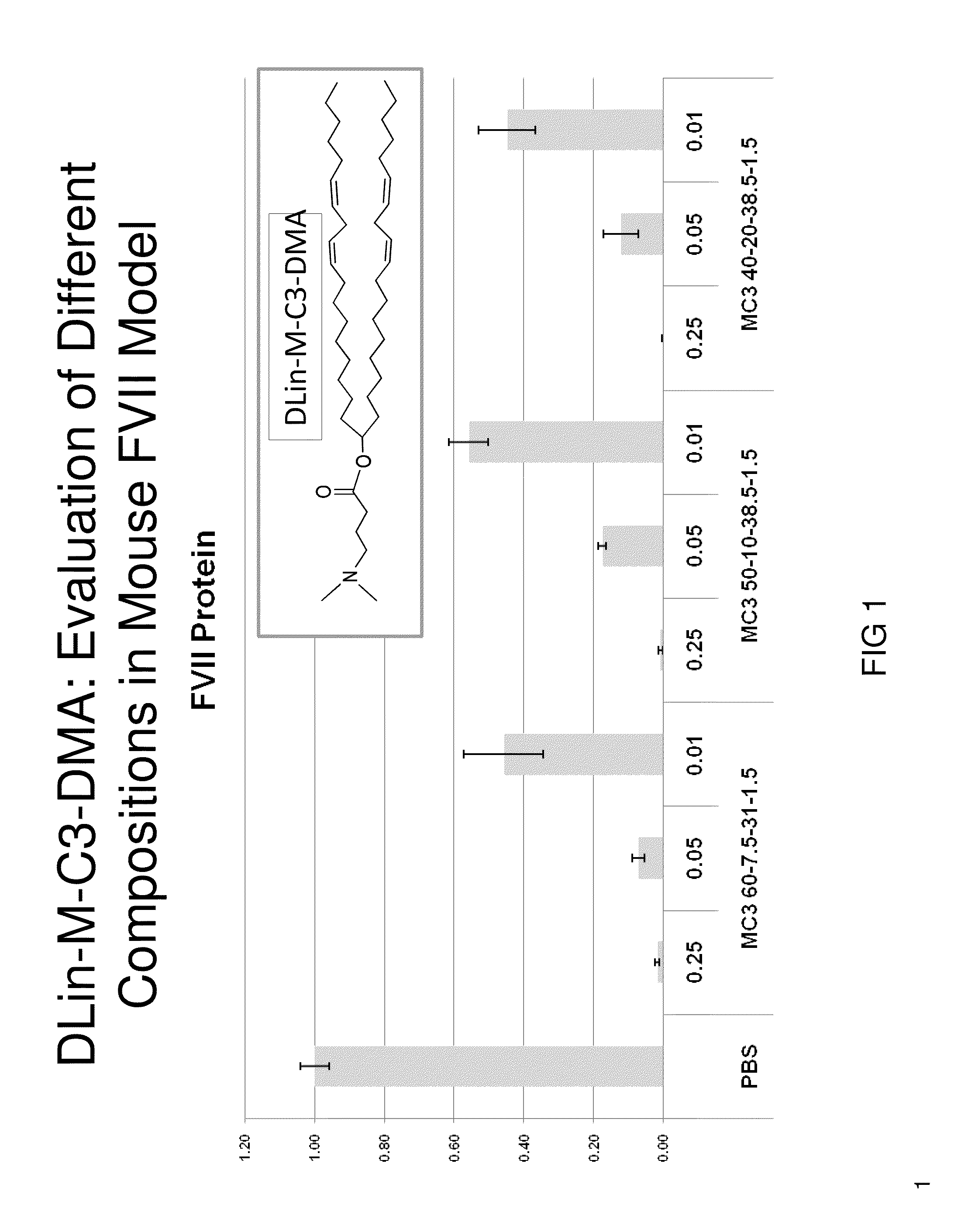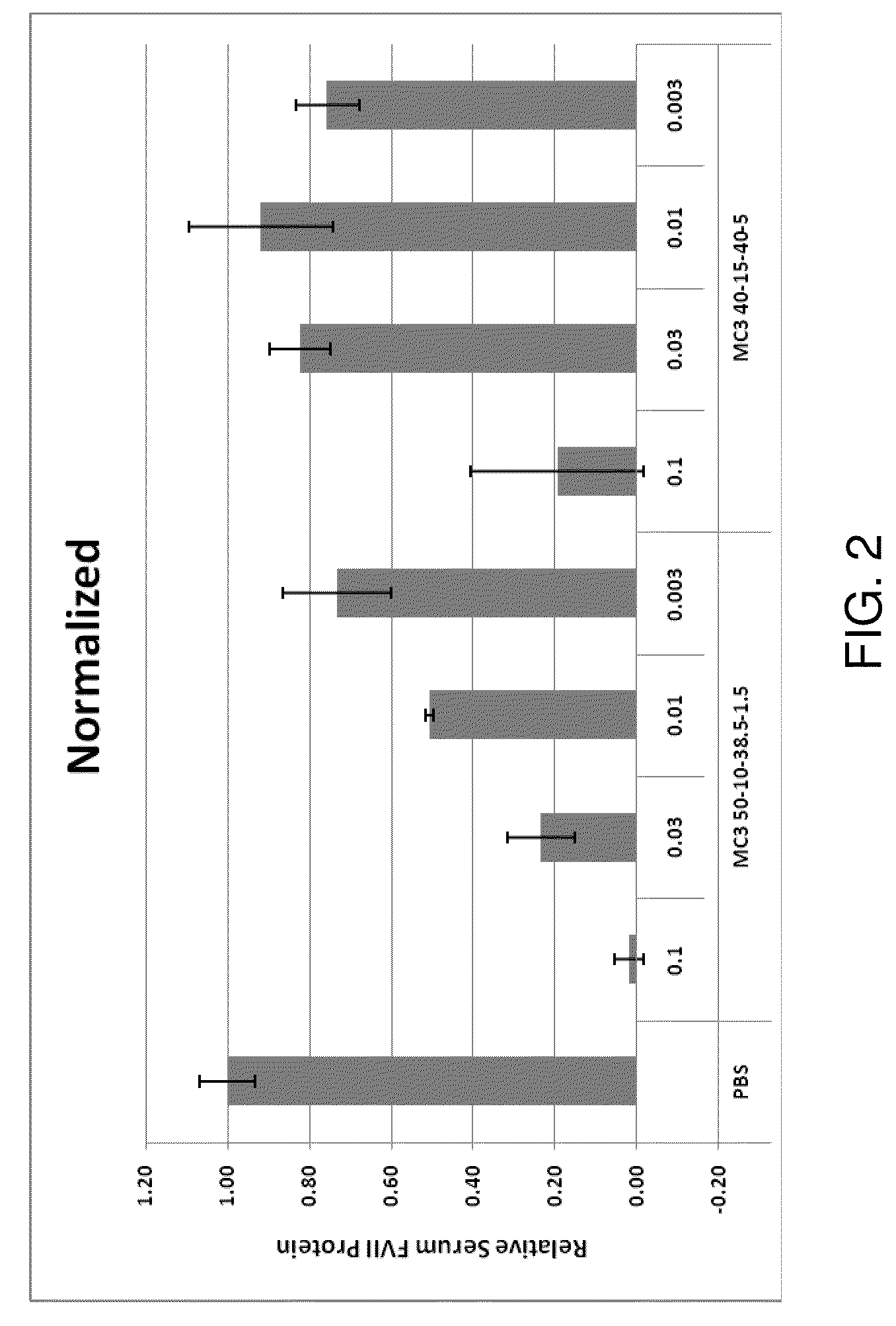Lipid formulation
a technology of lipids and lipid particles, which is applied in the direction of ester active ingredients, drug compositions, cardiovascular disorders, etc., can solve the problems of reducing the activity of the construct, reducing the ability to gain access to the intracellular compartment, and reducing the susceptibility of plasma nuclease digestion, so as to increase the expression of the polypeptide or the functional variant or fragment thereo
- Summary
- Abstract
- Description
- Claims
- Application Information
AI Technical Summary
Benefits of technology
Problems solved by technology
Method used
Image
Examples
example 1
siRNA Duplexes for Luc and FVII Targeting
[0461]Table 8 below provides exemplary sequences for the targeting of Luc. and FVII.
[0462]
TABLE 8Sense / SEQ IDTar-DuplexAntisenseSequence 5′-3′NO:get1000 / 2434CUU ACG CUG AGU ACU UCG 1LucAdTdT U*CG AAG fUAC UCA GCG69fUAA GdT*dT2433 / 1001C*UfU ACG CUG AGfU ACU70LucUCG AdT*dTUCG AAG UAC UCA GCG UAA71GdTdT2433 / 2434C*UfU ACG CUG AGfU ACU72LucUCG AdT*dTU*CG AAG fUAC UCA GCG73fUAA GdT*dT1000 / 1001CUU ACG CUG AGU ACU UCG74LucAdTdTUCG AAG UAC UCA GCG UAA75GdTdTAD-1596GGAUCAUCUCAAGUCUUACdTdT76FVIIGUAAGACUUGAGAUGAUCCdTdT77AD-1661GGAfUfCAfUfCfUfCAAGfUfC78FVIIfUfUAfCdTsdTGfUAAGAfCfUfUGAGAfUGAfU79fCfCdT*dT
example 2
FVII In Vivo Evaluation Using the Cationic Lipid Derived Liposomes
[0463]In vivo rodent Factor VII and ApoB silencing experiments. C57BL / 6 mice (Charles River Labs, MA) and Sprague-Dawley rats (Charles River Labs, MA) received either saline or siRNA in desired formulations via tail vein injection at a volume of 0.01 mL / g. At various time points post-administration, animals were anesthesized by isofluorane inhalation and blood was collected into serum separator tubes by retro orbital bleed. Serum levels of Factor VII protein were determined in samples using a chromogenic assay (Coaset Factor VII, DiaPharma Group, OH or Biophen FVII, Aniara Corporation, OH) according to manufacturer protocols. A standard curve was generated using serum collected from saline treated animals. In experiments where liver mRNA levels were assessed, at various time points post-administration, animals were sacrificed and livers were harvested and snap frozen in liquid nitrogen. Frozen liver tissue was ground ...
example 3
Liposome Formulations for FVII Targeting
[0464]Factor VII (FVII), a prominent protein in the coagulation cascade, is synthesized in the liver (hepatocytes) and secreted into the plasma. FVII levels in plasma can be determined by a simple, plate-based colorimetric assay. As such, FVII represents a convenient model for determining sirna-mediated downregulation of hepatocyte-derived proteins, as well as monitoring plasma concentrations and tissue distribution of the nucleic acid lipid particles and siRNA.
[0465]Factor VII Knockdown in Mice
[0466]FVII activity was evaluated in FVII siRNA-treated animals at 24 hours after intravenous (bolus) injection in C57BL / 6 mice. FVII was measured using a commercially available kit for determining protein levels in serum or tissue, following the manufacturer's instructions at a microplate scale. FVII reduction was determined against untreated control mice, and the results were expressed as % Residual FVII. Four dose levels (2, 5, 12.5, 25 mg / kg FVII si...
PUM
| Property | Measurement | Unit |
|---|---|---|
| molecular weight | aaaaa | aaaaa |
| molecular weight | aaaaa | aaaaa |
| molecular weight | aaaaa | aaaaa |
Abstract
Description
Claims
Application Information
 Login to View More
Login to View More - R&D
- Intellectual Property
- Life Sciences
- Materials
- Tech Scout
- Unparalleled Data Quality
- Higher Quality Content
- 60% Fewer Hallucinations
Browse by: Latest US Patents, China's latest patents, Technical Efficacy Thesaurus, Application Domain, Technology Topic, Popular Technical Reports.
© 2025 PatSnap. All rights reserved.Legal|Privacy policy|Modern Slavery Act Transparency Statement|Sitemap|About US| Contact US: help@patsnap.com



